driver seat adjustment LINCOLN MKC 2015 Owners Manual
[x] Cancel search | Manufacturer: LINCOLN, Model Year: 2015, Model line: MKC, Model: LINCOLN MKC 2015Pages: 490, PDF Size: 4.74 MB
Page 4 of 490
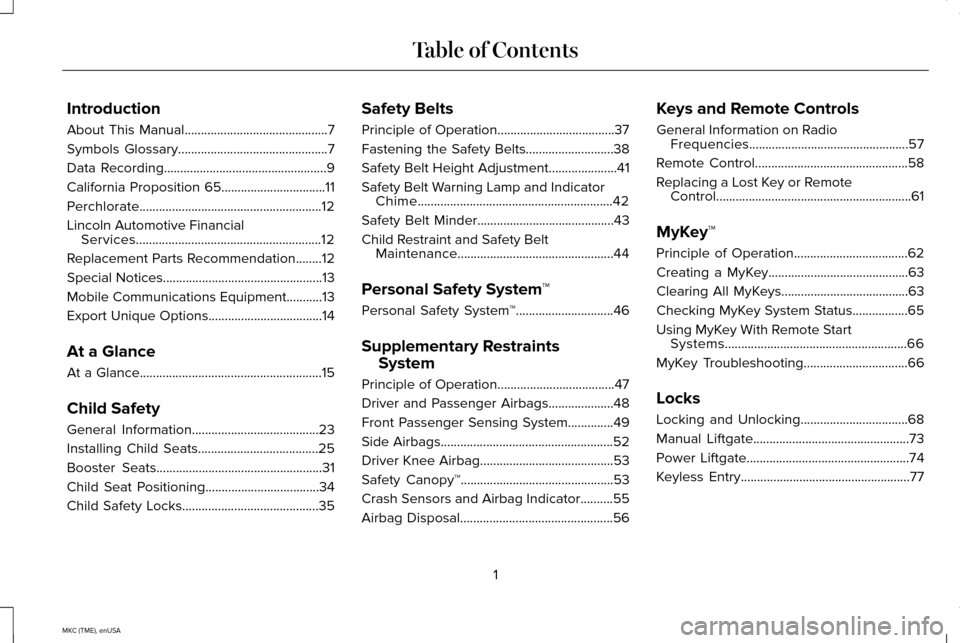
Introduction
About This Manual............................................7
Symbols Glossary
..............................................7
Data Recording
..................................................9
California Proposition 65................................11
Perchlorate........................................................12
Lincoln Automotive Financial Services
.........................................................12
Replacement Parts Recommendation........12
Special Notices
.................................................13
Mobile Communications Equipment...........13
Export Unique Options...................................14
At a Glance
At a Glance........................................................15
Child Safety
General Information
.......................................23
Installing Child Seats
.....................................25
Booster Seats...................................................31
Child Seat Positioning...................................34
Child Safety Locks..........................................35 Safety Belts
Principle of Operation....................................37
Fastening the Safety Belts...........................38
Safety Belt Height Adjustment
.....................41
Safety Belt Warning Lamp and Indicator Chime............................................................42
Safety Belt Minder..........................................43
Child Restraint and Safety Belt Maintenance................................................44
Personal Safety System ™
Personal Safety System ™
..............................46
Supplementary Restraints System
Principle of Operation
....................................47
Driver and Passenger Airbags....................48
Front Passenger Sensing System
..............49
Side Airbags
.....................................................52
Driver Knee Airbag.........................................53
Safety Canopy™...............................................53
Crash Sensors and Airbag Indicator..........55
Airbag Disposal
...............................................56 Keys and Remote Controls
General Information on Radio
Frequencies.................................................57
Remote Control
...............................................58
Replacing a Lost Key or Remote Control............................................................61
MyKey™
Principle of Operation...................................62
Creating a MyKey...........................................63
Clearing All MyKeys.......................................63
Checking MyKey System Status
.................65
Using MyKey With Remote Start Systems........................................................66
MyKey Troubleshooting
................................66
Locks
Locking and Unlocking
.................................68
Manual Liftgate................................................73
Power Liftgate..................................................74
Keyless Entry
....................................................77
1
MKC (TME), enUSA Table of Contents
Page 42 of 490
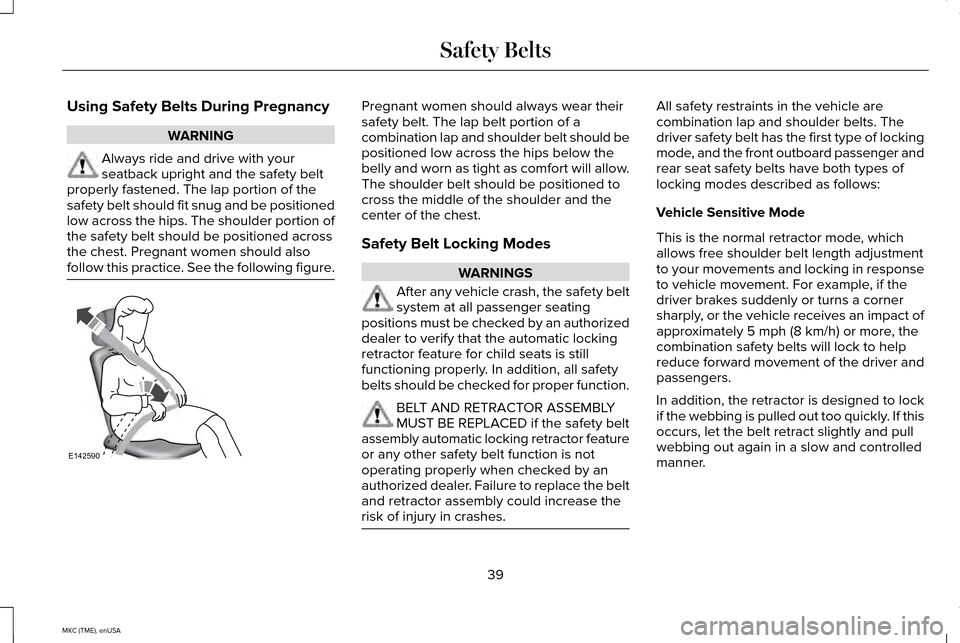
Using Safety Belts During Pregnancy
WARNING
Always ride and drive with your
seatback upright and the safety belt
properly fastened. The lap portion of the
safety belt should fit snug and be positioned
low across the hips. The shoulder portion of
the safety belt should be positioned across
the chest. Pregnant women should also
follow this practice. See the following figure. Pregnant women should always wear their
safety belt. The lap belt portion of a
combination lap and shoulder belt should be
positioned low across the hips below the
belly and worn as tight as comfort will allow.
The shoulder belt should be positioned to
cross the middle of the shoulder and the
center of the chest.
Safety Belt Locking Modes
WARNINGS
After any vehicle crash, the safety belt
system at all passenger seating
positions must be checked by an authorized
dealer to verify that the automatic locking
retractor feature for child seats is still
functioning properly. In addition, all safety
belts should be checked for proper function. BELT AND RETRACTOR ASSEMBLY
MUST BE REPLACED if the safety belt
assembly automatic locking retractor feature
or any other safety belt function is not
operating properly when checked by an
authorized dealer. Failure to replace the belt
and retractor assembly could increase the
risk of injury in crashes. All safety restraints in the vehicle are
combination lap and shoulder belts. The
driver safety belt has the first type of locking
mode, and the front outboard passenger and
rear seat safety belts have both types of
locking modes described as follows:
Vehicle Sensitive Mode
This is the normal retractor mode, which
allows free shoulder belt length adjustment
to your movements and locking in response
to vehicle movement. For example, if the
driver brakes suddenly or turns a corner
sharply, or the vehicle receives an impact of
approximately 5 mph (8 km/h) or more, the
combination safety belts will lock to help
reduce forward movement of the driver and
passengers.
In addition, the retractor is designed to lock
if the webbing is pulled out too quickly. If this
occurs, let the belt retract slightly and pull
webbing out again in a slow and controlled
manner.
39
MKC (TME), enUSA Safety BeltsE142590
Page 52 of 490
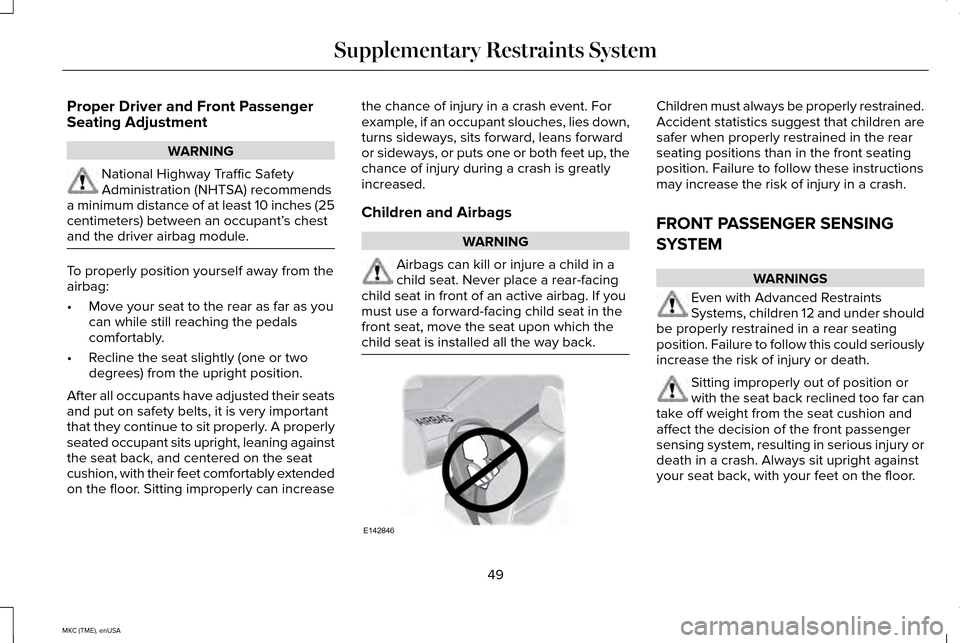
Proper Driver and Front Passenger
Seating Adjustment
WARNING
National Highway Traffic Safety
Administration (NHTSA) recommends
a minimum distance of at least 10 inches (25
centimeters) between an occupant’ s chest
and the driver airbag module. To properly position yourself away from the
airbag:
•
Move your seat to the rear as far as you
can while still reaching the pedals
comfortably.
• Recline the seat slightly (one or two
degrees) from the upright position.
After all occupants have adjusted their seats
and put on safety belts, it is very important
that they continue to sit properly. A properly
seated occupant sits upright, leaning against
the seat back, and centered on the seat
cushion, with their feet comfortably extended
on the floor. Sitting improperly can increase the chance of injury in a crash event. For
example, if an occupant slouches, lies down,
turns sideways, sits forward, leans forward
or sideways, or puts one or both feet up, the
chance of injury during a crash is greatly
increased.
Children and Airbags
WARNING
Airbags can kill or injure a child in a
child seat. Never place a rear-facing
child seat in front of an active airbag. If you
must use a forward-facing child seat in the
front seat, move the seat upon which the
child seat is installed all the way back. Children must always be properly restrained.
Accident statistics suggest that children are
safer when properly restrained in the rear
seating positions than in the front seating
position. Failure to follow these instructions
may increase the risk of injury in a crash.
FRONT PASSENGER SENSING
SYSTEM
WARNINGS
Even with Advanced Restraints
Systems, children 12 and under should
be properly restrained in a rear seating
position. Failure to follow this could seriously
increase the risk of injury or death. Sitting improperly out of position or
with the seat back reclined too far can
take off weight from the seat cushion and
affect the decision of the front passenger
sensing system, resulting in serious injury or
death in a crash. Always sit upright against
your seat back, with your feet on the floor.
49
MKC (TME), enUSA Supplementary Restraints SystemE142846
Page 148 of 490
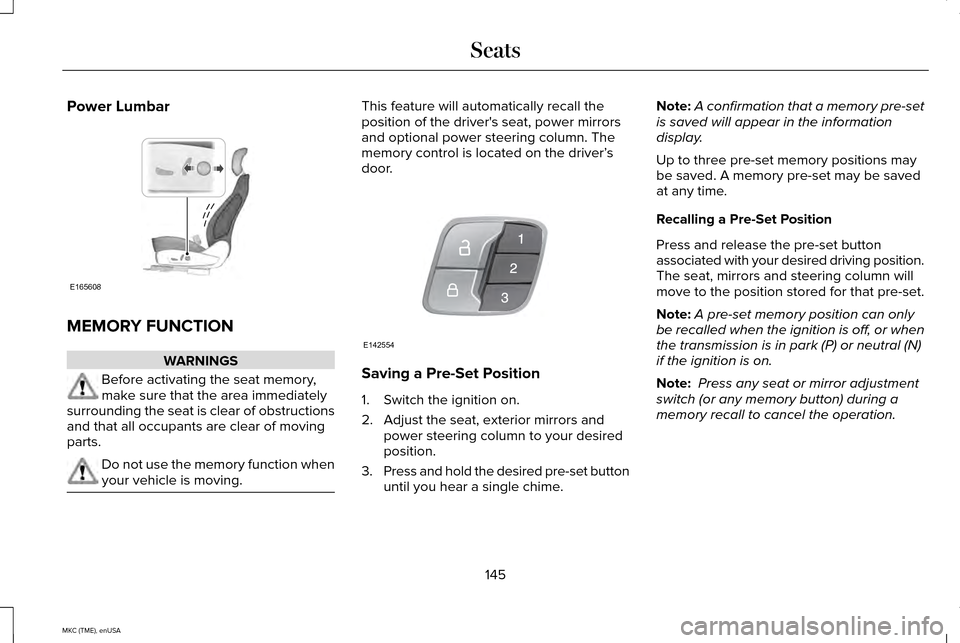
Power Lumbar
MEMORY FUNCTION
WARNINGS
Before activating the seat memory,
make sure that the area immediately
surrounding the seat is clear of obstructions
and that all occupants are clear of moving
parts. Do not use the memory function when
your vehicle is moving. This feature will automatically recall the
position of the driver's seat, power mirrors
and optional power steering column. The
memory control is located on the driver’
s
door. Saving a Pre-Set Position
1. Switch the ignition on.
2. Adjust the seat, exterior mirrors and
power steering column to your desired
position.
3. Press and hold the desired pre-set button
until you hear a single chime. Note:
A confirmation that a memory pre-set
is saved will appear in the information
display.
Up to three pre-set memory positions may
be saved. A memory pre-set may be saved
at any time.
Recalling a Pre-Set Position
Press and release the pre-set button
associated with your desired driving position.
The seat, mirrors and steering column will
move to the position stored for that pre-set.
Note: A pre-set memory position can only
be recalled when the ignition is off, or when
the transmission is in park (P) or neutral (N)
if the ignition is on.
Note: Press any seat or mirror adjustment
switch (or any memory button) during a
memory recall to cancel the operation.
145
MKC (TME), enUSA SeatsE165608 E142554
Page 480 of 490
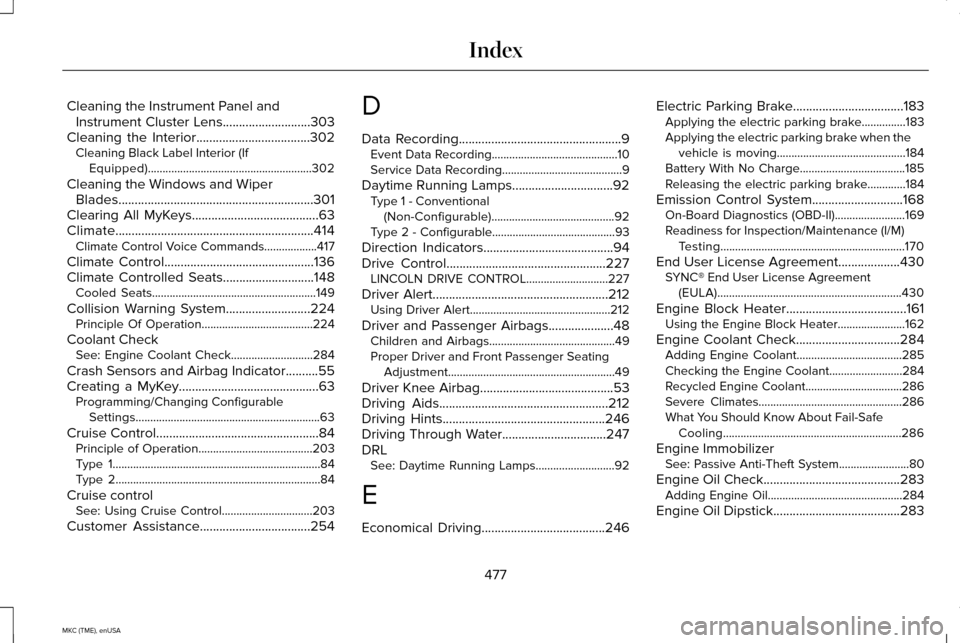
Cleaning the Instrument Panel and
Instrument Cluster Lens...........................303
Cleaning the Interior...................................302 Cleaning Black Label Interior (If
Equipped)........................................................302
Cleaning the Windows and Wiper Blades............................................................301
Clearing All MyKeys.......................................63
Climate.............................................................414 Climate Control Voice Commands..................417
Climate Control..............................................136
Climate Controlled Seats............................148
Cooled Seats........................................................149
Collision Warning System
..........................224
Principle Of Operation......................................224
Coolant Check See: Engine Coolant Check............................284
Crash Sensors and Airbag Indicator..........55
Creating a MyKey...........................................63 Programming/Changing Configurable
Settings...............................................................63
Cruise Control
..................................................84
Principle of Operation.......................................203
Type 1.......................................................................84
Type 2......................................................................84
Cruise control See: Using Cruise Control...............................203
Customer Assistance
..................................254 D
Data Recording
..................................................9
Event Data Recording...........................................10
Service Data Recording.........................................9
Daytime Running Lamps...............................92 Type 1 - Conventional
(Non-Configurable)
..........................................92
Type 2 - Configurable..........................................93
Direction Indicators........................................94
Drive Control
.................................................227
LINCOLN DRIVE CONTROL............................227
Driver Alert
......................................................212
Using Driver Alert................................................212
Driver and Passenger Airbags....................48 Children and Airbags...........................................49
Proper Driver and Front Passenger Seating
Adjustment.........................................................49
Driver Knee Airbag.........................................53
Driving Aids
....................................................212
Driving Hints..................................................246
Driving Through Water................................247
DRL See: Daytime Running Lamps...........................92
E
Economical Driving......................................246 Electric Parking Brake
..................................183
Applying the electric parking brake...............183
Applying the electric parking brake when the
vehicle is moving............................................184
Battery With No Charge....................................185
Releasing the electric parking brake.............184
Emission Control System
............................168
On-Board Diagnostics (OBD-II)........................169
Readiness for Inspection/Maintenance (I/M)
Testing...............................................................170
End User License Agreement
...................430
SYNC® End User License Agreement
(EULA)...............................................................430
Engine Block Heater.....................................161 Using the Engine Block Heater.......................
162
Engine Coolant Check................................284 Adding Engine Coolant....................................285
Checking the Engine Coolant.........................284
Recycled Engine Coolant.................................
286
Severe Climates.................................................286
What You Should Know About Fail-Safe Cooling.............................................................286
Engine Immobilizer See: Passive Anti-Theft System........................80
Engine Oil Check
..........................................283
Adding Engine Oil..............................................284
Engine Oil Dipstick
.......................................283
477
MKC (TME), enUSA Index